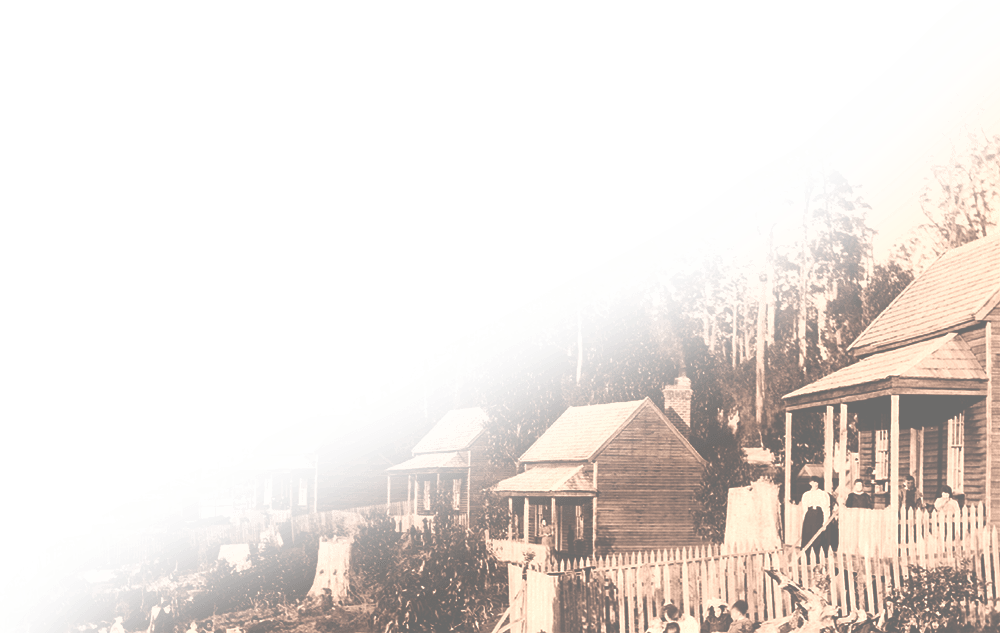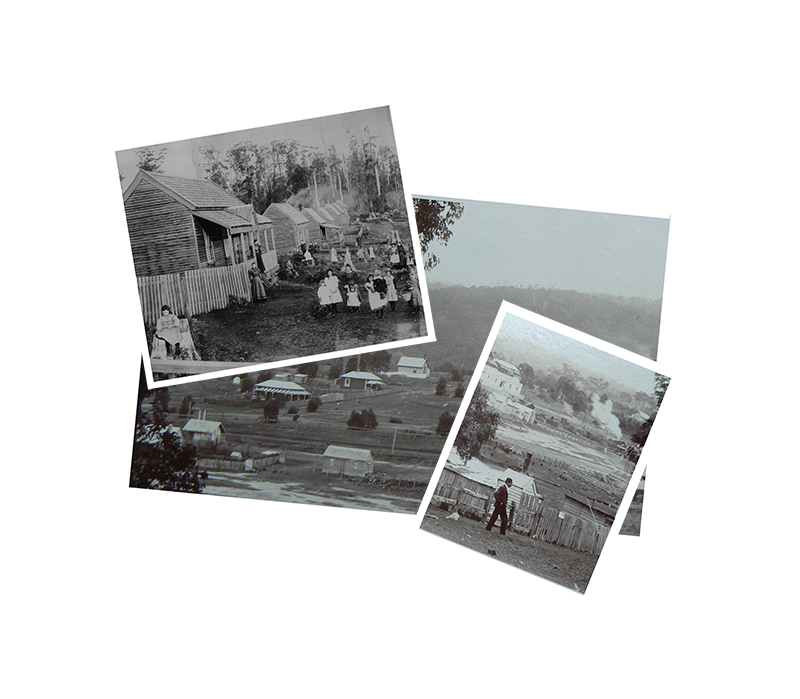WANDONG HISTORY GROUP INC.
WANDONG HISTORY GROUP INC.
About Us
About Us


Timber, by Jinker or Rail. Sawmilling in Mt Disappointment.
The early history of sawmilling in Victoria is difficult to define. Demand for timber was based purely on the establishment of settlements, thus the presence of mills within the state rose and fell accordingly. The rate of timber harvested from the forests also waxed and waned according to factors such as economic development, timber supply, quality and the vagaries of nature. In general the area of sawmilling focus would change every decade, as different areas became settled.
Prior to 1950 few sawmillers spent their working life in one area; rather they became a nomadic group moving from area to area. This is particularly noted within the Mt Disappointment area, as mills shifted with the timber supply and men who worked in local mills moved as far as Western Australia when operations wound down.
The operation of the early mills was a simple process, success or failure depended on how efficiently logs and sawn timber were transported. Before the connection of roads and modern day trucks, tramways were a relatively inexpensive way of moving logs and timber. Gravity was employed to make use of the hilly terrain, where loaded trucks of logs were sent careering downhill on rails with a brakeman aboard the load. Winches, were employed where loads had to be hauled up steep inclines, horses were used to haul logs through the forest and eventually the use of the steam locomotive revolutionised the process, allowing larger logs and bigger loads to be carried from bush to mill and to the local railhead.
BEFORE SAW MILLING IN MT DISAPPOINTMENT STATE FOREST.
The Paling Splitter
The skill of the paling splitter: “He must be a good judge of standing timber, or the felling of “duffers”, will waste many precious hours. He must know how to handle his wood, so as to get the best possible result for the least labour, and above all he must be an earnest big hearted “grafter”. There is a certain knack about splitting of which the proficient paling splitter is extremely proud.” Most splitters lived nearby to the forest but spent their working week living in a rough hut in the bush, usually with a mate as splitters rarely worked alone. This was due to the fear of meeting with a serious accident which were common place in the forest. Usually one man did the splitting while the other sawed and billeted the timber. Both worked on the actual felling of the tree. Once the tree was on the ground it was sawn into lengths, the billeter using maul and wedges split the logs into billets each containing eight palings. Using a razor edged knife fixed at right angles to the handle the splitter halved the billets driving the knife in with a “babby” (splitters name for a mallet), these billets were halved again until eight palings were run out, placed together in their former order and made ready for the buyer.
By 1875 the saw-millers presence was to take effect. This was also the beginning of a tirade of letters appearing in newspapers as the saw millers began to push into forest areas previously the exclusive domain of the splitters. Mickey Free of Trentham wrote,” There is at present a rather unpleasant feeling existing between the saw mill owners and a few men who earn their living by splitting in the forest. The saw-mill clique are attempting to expel the splitters: they say the splitters are destroying the timber”
It wasn’t long after this that the problems appeared in the Plenty Ranges catchment area; initially in 1875 there was a push to remove the splitters in particular but also the saw millers from the Plenty Ranges, citing the protection of the watershed. The Water Authority sought to declare the Plenty Ranges Reserve, thereby removing everyone from the forest and, “The splitters are hunted over the ranges into more difficult and inhospitable regions, and the latest restriction of sending the splitters more than two miles north of the crest of the hill outside the drainage area is an additional aggravation of our grievances, as this belt of country contains the best of the timber suitable for sawmills and splitting purposes”.
The debate raged on, by 1876 there was a call for a new management system for all the forests which had been managed under a State Forest Board which was not particularly successful and was, “ineffective at checking waste, preventing disputes or providing for a future supply of timber. The serviceable trees are rapidly disappearing from the older forests and there are but few growing to fill their places. Little has been done with the exception of furnishing annual reports and looking after a few licence fees”.
The Derril Sawmill
The Derril Sawmill was established about by Abraham Neill at the headwaters of the Strath Creek. Abraham Neill had been working the forest from about 1870 probably one of the earliest sawmillers in the area. The Derril mill was purchased around 1888 by Robert Affleck Robertson and like so many others was the victim of fire. By this time Robertson had established his Comet Mill which was in fact a small village, the fire decimated the small mill which was eventually abandoned and only in recent times has the remains of the mill been located.
Greens Sawmill
In 1907 Edward Green in partnership with Mr. W Tratford began a saw milling operation with “A very fine forest of timber to work on”. The timber was typical of the Mt Disappointment area, comprising mainly messmate, stringy bark and blue gum. All timber milled here was taken to Broadford by road as there was a “Very good road running from Broadford right to the mill”. Green and Tratford intended to construct a tramline to convey timber to the railway, but this never eventuated.
Difficulty was encountered in getting horse and bullock teams to work the mill, as high demand left few teams available. Green’s mill had many orders mainly from the Victorian government, a large consumer of timber, using it as flooring in trucks and other uses. The mill struggled to fulfil its orders, and with only twelve hands employed the mills output was limited. Weather also played its part with the winter months making the road to Broadford impassable, however the mill continued to stockpile timber, ready for shipment once the roads were open again.
Argus Thursday 17 November 1910.
REEDY CREEK- Wednesday.- While Mr Edward Green sawmill proprietor, was on Saturday stacking timber at his mill, a piece of timber struck him on the nose, fracturing it. Portion of the bone adhered to the timber. The sufferer was driven to Broadford, as distance of 13 miles for treatment.
Slocomb and Walker Sawmill
The mill was originally part of an extensive integrated sawmilling and timber processing operation conducted by the Australian Seasoned Timber Company Ltd based at Wandong and Comet Mill during the period 1884-1903, and probably reused equipment from the company’s Planet Sawmill. The mill was installed late in the Company’s life, probably about 1901, after all logs that could be readily extracted through Wandong had been depleted. Unlike other mills operated by the company, sawn timber was despatched by road to the Whittlesea railway station. When the company ceased operations the mill was sold to Reuben Slocomb (the mill manager) in partnership with Peter Walker. The mill was demolished by the explosion of the boiler on the morning of Monday 23 May 1904.
The following day the Argus (page 6) reported: A boiler explosion occurred this morning at the sawmill of Messer’s Slocomb and Walker, eight miles from Whittlesea. On Saturday the engine was washed out. The certified driver, Charles Patton fired up at twenty minutes to seven. The gauge glass then showed half full. He then retired for breakfast. A number of sawyers live in huts around the mill, the nearest being three chains off. At three minutes to seven the explosion occurred. One man was thirty yards off, and a sheet of metal flew past him.
On cold mornings the men assemble around the boiler before starting work. Had they been two minutes earlier a dozen persons would have been killed. The engine, which was of sixteen horsepower, has given satisfaction and had been regularly tested. It is surmised that the safety valve was screwed down too tightly. Not only the engine but all the works were demolished. Mr Slocumb estimates he has lost £600. The mill has been working for eighteen months. Twenty men were thrown out of employment through the accident.
The mill was not rebuilt after the explosion and Slocomb and Walker relocated their operations to a new site three kilometres south west. When the mill boiler exploded, damaged equipment that was not worth salvaging was abandoned on site.
Article courtesy: Light Rail Research Society Australia and Colin Harvey
Several other mills operated in the area, the Phosphate mill located on the Bruces Creek was saved from bushfire in 1926, timber from this mill was transported to Whittlesea. W Knott operated a sawmill for 9 years and Johnston for about four years. Nothing compared to the grandeur of the Robertson enterprises which are outlined on other pages.

Recording and Preserving Our Past










